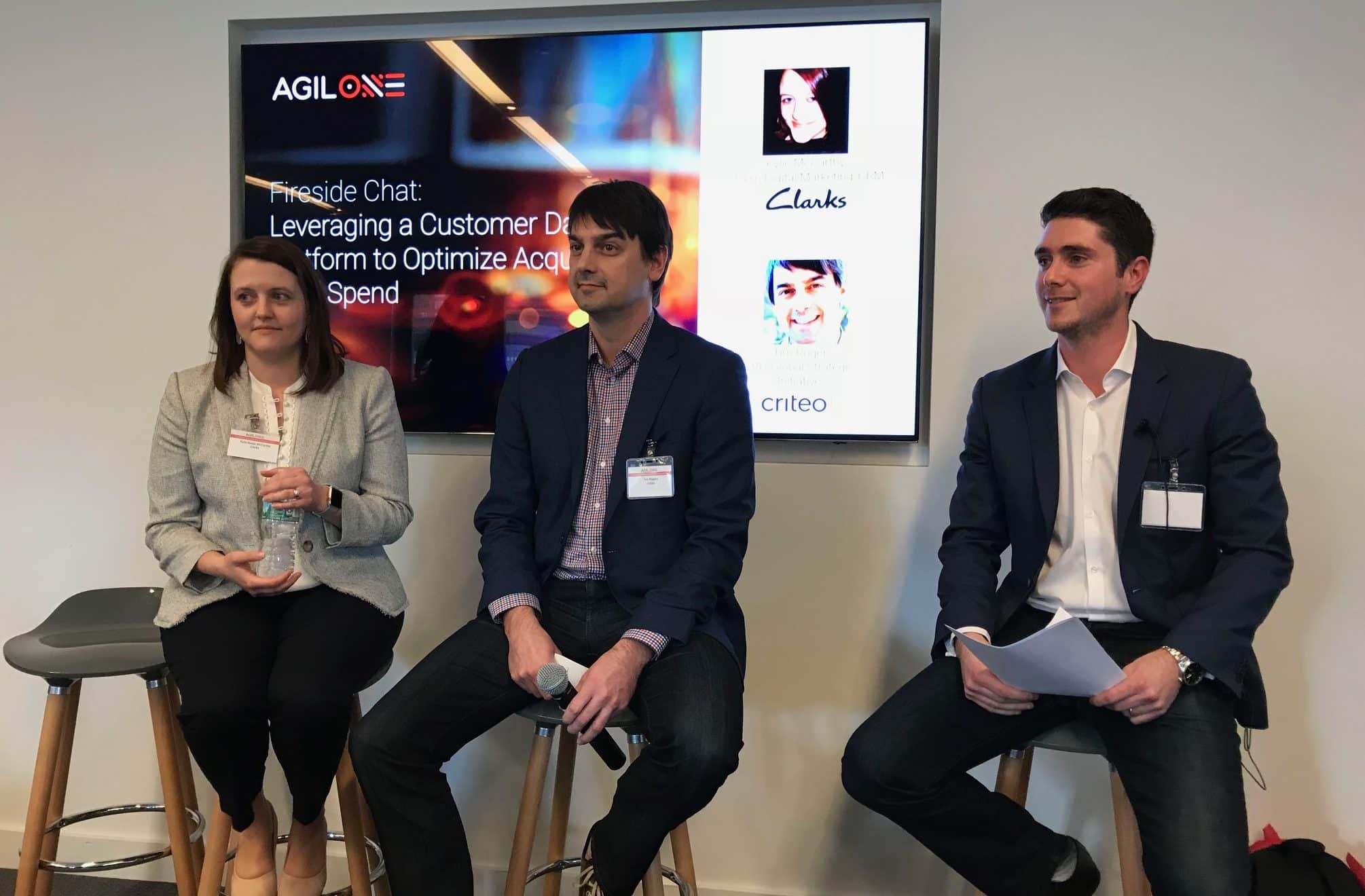Last Thursday, Criteo took part in AgilOne’s Customer Data Platform Summit where brands and retailers gathered to share challenges and exchange ideas on how to get the most out of their customer data.
Alongside speakers from the CDP Institute, Tumi, David’s Tea, and Clarks, our own VP of Global Strategic Initiatives Tim Rogers, took part in the discussions. He had an informative fireside chat with Clarks Sr. Director of Digital Marketing and CRM Kylie McCarthy to share insights on how brands and retailers can leverage a customer data platform and optimize acquisition and ad spend.
Here are seven key takeaways we learned from the summit:
1. Clean up your data
According to Tumi’s Chief Digital Officer Charlie Cole, you have to organize your data to get the most from it. Customer data, third-party data, and everything else has to be de-siloed and streamlined.
The data has to be cleansed, too, in order to remove or correct corrupt or incomplete information. You also have to check for data duplications that can skew results or statistics.
2. Redefine what “customer data” means for you
One retailer’s discarded data set is another’s goldmine. Whether you’re looking at geography, location preference, product preference, organizing your data provides you the opportunity to plan for the future.
“In the old world, it was just purchase history,” says Tumi’s Cole. “That is backward-looking data. It is not predictive, it’s reactive. You need to get enough data on the platform to get predictive intelligence.”
3. Educate, Educate, Educate
For both Tumi and David’s Tea, this means investing heavily in both employee product and data training.
For Tumi, data training is a key element of having employees understand what he calls “the omnichannel effects of data.”
“If you don’t educate people on [the effects], your organization will have huge blind spots” and missed opportunities.
For Catherine LaPorte, head of marketing at David’s Tea, investing in employee training and product knowledge is essential to building their brand identity and community.
“Our customer touch points are multiplying,” said LaPorte, “and we invest heavily in those one-to-one relationships.”
4. Trust the machine: don’t guess what the data can tell you

The speakers advised other brands and retailers in the room to trust the machine and stop guessing at certain aspects of customer behavior when data tells you otherwise.
For Tumi, it was machine learning that provided the insight that women were equally if not more interested in durable, basic black leather luggage than in lightweight, seasonal pastels. At David’s Tea, data offered new customer insights that made it possible to create meaningful experiences at touch points beyond the store.
And at Clarks, it was machine learning that showed Kylie McCarthy’s team that 83% of people who buy in-store had never been to the website.
5. Understand your customer better and put them first.
“Remember your data is there to support your product and your brand,” said Cole. And, to do this, marketers must put the customer at the center of all their planning.
“Organize your existing data,” repeated Cole, “and use that data to make sure your current customers are happy. Start with your core.”
For Tumi, this meant emphasizing pre and post-sale customer service including comprehensive warranties and product repair services and personalization. For David’s tea, it meant establishing a strong loyalty program called Frequent Steepers, and making sure their omnichannel experience from web to social to in-store was seamless.
And for Clarks, it meant spending campaign money on an unexpected segment of their customer base.
6. Leverage your data to optimize acquisition and ad spend
For Clarks, the goal now was to figure out whether the 83% of people who had never been to the website were worth the ad spend to be targeted by digital campaigns.
To determine this, McCarthy turned to both Criteo and AgilOne’s machine learning to drive smarter advertising.
“Criteo develops an individualized propensity score that we understand about every single Clarks site visitor,” said Rogers, “If there’s a consumer we believe has a high likelihood to convert we’re going to bid higher across our ecosystem.”
By pairing Criteo’s propensity scores with AgilOne’s, McCarthy was able to find that Clarks’ in-store shoppers were valuable targets for digital campaigns after all.
“[They were] an important touchpoint for me in a way I might not have assumed before.”
Make Data-Centricity a Priority
Whether you’re aiming to get new customers or build loyalty with existing ones, data will be at the center of everything you do. And it pays to be prepared. In a recently-released research report, “The Data Centric Organization 2018,” the Winterberry Group finds that marketers and publishers remain intensely focused on achieving “data-centricity” and that of those surveyed, 90.1% intend on developing an enterprise strategy to support the use of audience data.
However, only 1.3% of those surveyed in the report said they were “extremely confident” their organizations had the right expertise in data modeling, segmentation, and attribution. To become truly data-centric and get the most out of your data and data platforms, marketers will need to, as mentioned in takeaway number three above, educate, educate, educate. Only then will you be able to get the most out of your data to create personalized campaigns and increase profitability.
To learn more about what it takes to become a data-centric organization in 2018, read the report below!
https://www.slideshare.net/CriteoReports/dma-iab-winterberry-group-the-data-centric-organization-february-2018





















